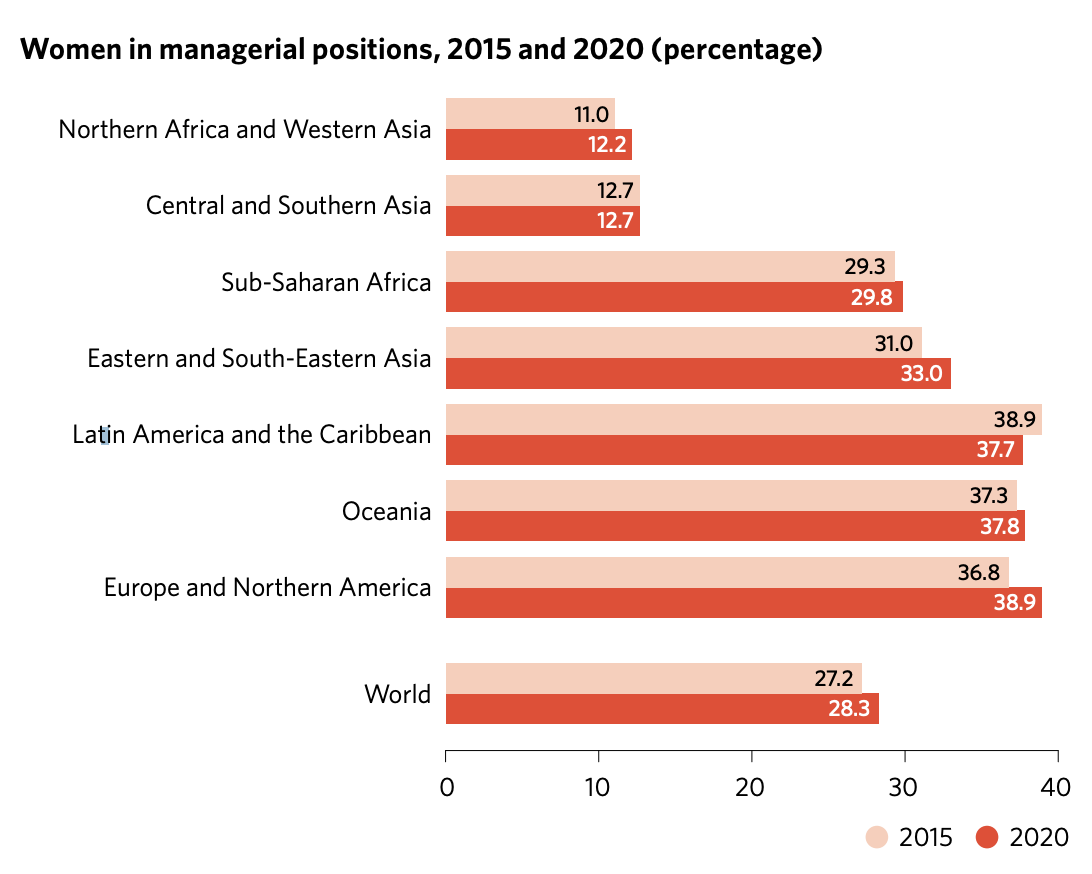What is the state of the gender pay gap in 2024?
The gender pay gap is alive and well – at the current rate of progress, the World Economics Forum says we’ll need 132 years to close it.

Contents
Almost a decade ago, The Economist reported that women earned a lot less than men despite decades of equal-pay laws. Around the world, this statement remains true in 2023. According to the World Economic Forum, at the current rate of progress, it will take 132 years to reach full parity where the global gender pay gap is fully closed. Perhaps unsurprisingly, no country has yet to achieve full gender parity. So if you’re questioning why progress is terrifyingly slow for something that has been around for decades, you’re not wrong to. But it’s not that nothing is being done. Seeds are being planted through strong campaigns drumming up awareness, and educating people who have otherwise seen the movement as nothing but a feminist myth. Cries for help to close the gap are getting louder. Governments are putting in effort to introduce pay transparency, in a bid to get employers to address the pay gap practically. Yet, global statistics prove that the gap has stagnated in recent years and that there is still room for improvement. It’s so dire that the United Nations has declared that the world is not on track to achieve gender equality by 2030. So what can you do as a business to help close the gender pay gap? Why is it important for you to address it when you have business as usual tasks to get on with? How do you build a business case to get your company to rally behind one of 2023’s biggest battles? Here’s how.

What is the gender pay gap?
It’s been more than a century since women first started making strides in the workplace. From establishing women’s right to work, to the ongoing fight for equal pay, it’s been a long, hard battle. But it doesn’t stop some people from dismissing it as a complete myth. According to The Guardian, a small, but vocal coalition of rightwing think tanks and men’s rights activists (the list goes on) view the gender pay gap as a “lie perpetuated by feminists who use statistics dishonestly to further their cause.” Thankfully, outside these groups, most folks understand that the gender pay gap is a very real thing that needs to be addressed. One of the better definitions out there is Gartner’s. Gartner defines the gender pay gap as “the average difference in earnings between men and women,” and as for why it’s classified as an actual pay gap: “data shows that women consistently earn less than men even after controlling for differences in age, occupation and location.”

What is the state of the gender pay gap globally in 2023?
We don’t have to go far to see how poorly things are going. The following statistics are just the tip of the iceberg.
- In Australia: pay secrecy has only just been repealed.
- In the UK: a campaign is on the way to make salary transparency a legal right, because the median pay gap between men and women has remained at 9.4% since 2017.
- In New Zealand: Mind The Gap is a pay gap registry founded by a philanthropic foundation, that shows whether or not a business has published their gender pay gap information.
- In Singapore: a campaign was designed urging people to donate their gender pay gap, to create more awareness in an effort to appeal to people who still seem to think gender pay gap is a myth despite reports on Singapore’s gender pay gap being very real.
- In Malaysia: the pay gap means that women work for free nearly two months of the year compared to the average man in employment.

Image Credit: Chapter 5 of the United Nations’s Sustainable Development Goals Report. Under Goal 5, Gender equality. As if those statistics didn’t paint a dark enough picture, the latest Sustainable Development Agenda by the United Nations echoes a stark but united sentiment. They’ve announced that “the world is not on track to achieve gender equality and the empowerment of all women and girls,” and progress on gender equality has “not only failed to move forward, but has begun to reverse.” What’s clear is women’s representation in positions of power and decision-making remains below parity. Which means workplaces can do better. Deep breaths everyone. We’ve got lots of work to do.

What elements are standing in the way of closing the gender pay gap?
According to the United Nations, the social and economic fallout from the pandemic has influenced the lack of progress in the closing of the gender pay gap. On top of that, a lack of reporting in this area is also cited, as they found that less than half of the data required to monitor their goal to close the gender pay gap by 2030 is available. In workplaces, they believe that not enough is being done to accelerate progress on women’s representation in decision-making positions, as well as the establishment of more laws, policies, budgets and institutions that advance gender equality.
What are the impacts of the gender pay gap?
The direct social and economic impacts on women created by the gender pay gap are intimidating. And very real. It’s acknowledged by the Equality and Human Rights commission, who act as Great Britain’s national equality body. They suggest that ultimately, “paying women less than men has far-reaching implications for society by contributing to the gender pay gap, as women’s lower pension contributions contribute to a higher likelihood of experiencing poverty in later life.”
How can employers help close the gender pay gap?
It’s safe to say that it won’t be long until the fight to help close the gender pay gap arrives at your company’s doorstep. The experts behind HR Magazine suggest that it will bode well for employers to plan to embrace pay transparency sooner rather than later. Around the world, there are also several laws that have either just been introduced, or are on the way, which require companies to disclose information that makes it easier for employees to compare salaries, and expose existing gender pay gaps. We will go into them later. Now is a good time to get involved and lead by example. There are a few ways you can do so:
Introduce pay transparency
Traditionally, people have been uncomfortable discussing salaries at work either because of a pay secrecy clause in their contract, didn’t know how or frankly, because they don’t want to. But breaking the taboo around discussing salaries is one of the best ways to address pay equality in the workplace. It also forces companies to think, sparking a change in employment practices. Christian Sutherland-Wong, Glassdoor’s Chief Executive Officer suggests that every company should be embracing pay transparency. And that, “by removing salary secrecy, employers can address potential pay gaps and ensure equal pay for equal work.”“Salary transparency empowers job seekers and employees to understand better what fair pay looks like for their experience and skills. In addition, employers see the benefits of a more productive and engaged workforce.”
End pay secrecy clauses
According to the BBC, traditionally, companies used pay secrecy clauses in employment contracts to promote pay secrecy either covertly or overtly, because it often saves them money. But this practice has a negative ripple effect “particularly [on] women and members of minority groups who tend to be paid less than white male counterparts,” as “these groups face more challenges negotiating for fair pay – which then feeds into the enduring wage gap.” The never ending cycle is relentless. Fortunately, some countries have started introducing laws and legislation to end pay secrecy clauses. Australia is one of the latest to impose a nationwide ban. As of 7th December 2022, Australian employees were given the right to elect whether they share information about their compensation or terms and conditions of employment. Later this year, all pay secrecy clauses will be null and void on or after 7th December 2023. Lynne Marie Finn, the President and CEO of Broadleaf believes that this is the right way forward. “Pay transparency is designed to help employers and employees avoid discrimination in discussing, disclosing or inquiring about compensation, which ultimately could eradicate the current wage gap based on gender.”
Introduce equal employment opportunities
The experts at ACAS describe equality in the workplace as equal job opportunities and fairness for employees and job applicants. No matter what industry or profession you’re in, fair employment still matters in this day and age. For many businesses, local legislation and laws tend to dictate what actions need to be done. A practical example might be the UK laws under the Equality Act 2010, which has a specific gender pay gap information regulation. This usually results in annual information gathering to review employees backgrounds and genders, as well as introducing workplace policies around this area to prevent things such as discrimination by gender, race, age and disability. The key is making sure your business has the right policies in place to look after your team, that goes beyond seeing them as statistics and output machines.
Look after your workforce with Employment Hero
Looking after your team should be your number one priority when it comes to workplace wellness. And that includes their financial wellbeing. Help close the gender pay gap by contributing your pay data to national statistics. Take action today by introducing anonymous gender pay gap reporting that shares pay information of your male and female employees, their age group and backgrounds. Stay engaged with your team and celebrate their achievements using Employment Hero. And most of all, make sure you’re having important conversations from day one.
Resources and further reading:
Related Resources
-
 Read more: Employment Hero Named Australia’s Most Recommended in 2025 Finder Awards
Read more: Employment Hero Named Australia’s Most Recommended in 2025 Finder AwardsEmployment Hero Named Australia’s Most Recommended in 2025 Finder Awards
Employment Hero was voted the most trusted and recommended HR software in the 2025 Finder awards from more than 60,000…
-
 Read more: Employment Uncovered 2025: The Story of Australian Work
Read more: Employment Uncovered 2025: The Story of Australian WorkEmployment Uncovered 2025: The Story of Australian Work
Inside the story of Australian work in 2025. From rising ‘sickies’ to hiring fatigue, see how workforce patterns are shifting.…
-
 Read more: PEO vs. EOR: A guide to global hiring
Read more: PEO vs. EOR: A guide to global hiringPEO vs. EOR: A guide to global hiring
Learn the key differences between a PEO and an EOR. Discover why an EOR is the smarter, safer way to…
























